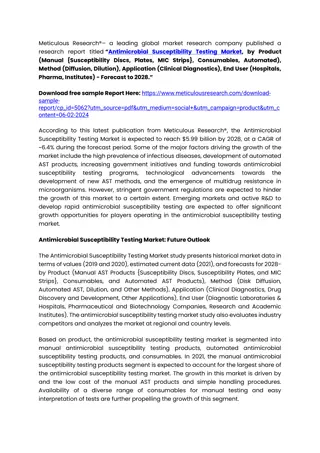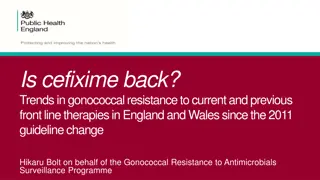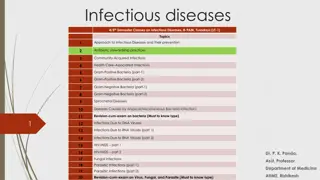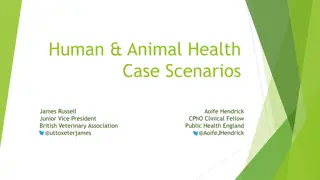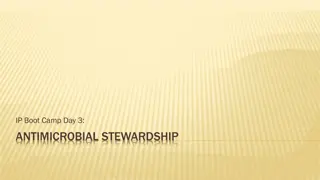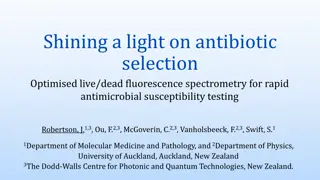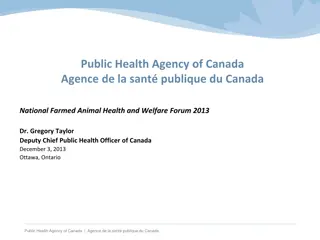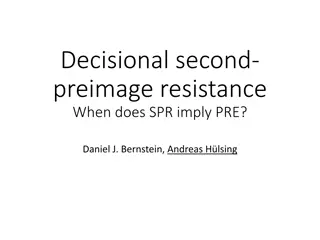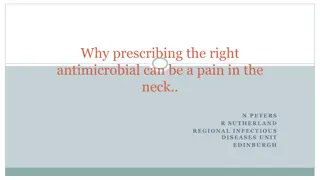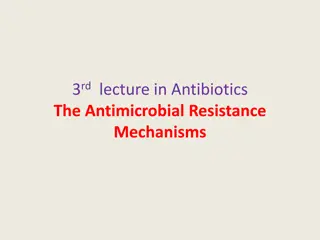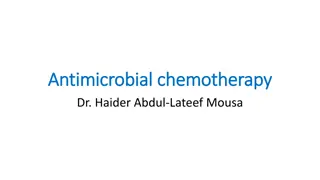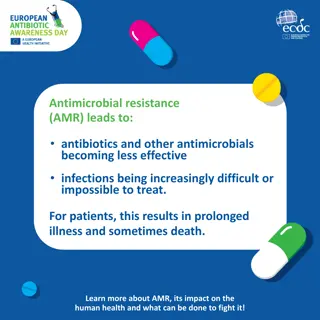Climate Change and Antimicrobial Resistance Relationship
Examining the potential link between climate change and antimicrobial resistance, this study discusses the impact of climate change on human health and the ecological pressure exerted by antimicrobial use. The findings highlight the urgent need for global actions to address antimicrobial resistance and climate change.
Download Presentation

Please find below an Image/Link to download the presentation.
The content on the website is provided AS IS for your information and personal use only. It may not be sold, licensed, or shared on other websites without obtaining consent from the author.If you encounter any issues during the download, it is possible that the publisher has removed the file from their server.
You are allowed to download the files provided on this website for personal or commercial use, subject to the condition that they are used lawfully. All files are the property of their respective owners.
The content on the website is provided AS IS for your information and personal use only. It may not be sold, licensed, or shared on other websites without obtaining consent from the author.
E N D
Presentation Transcript
IF: 4.614 Presenter : Zahra Tahmasebi 2
Abstract Methods Introduction Discussion Conclusions Searched PubMed and Web of Science databases for articles published from inception to 1 September 2022. Keywords: Climate change AND ( Antimicrobial resistance OR Antibiotic resistance They discussed the potential relationship between climate change and antimicrobial resistance. 3
Abstract Introduction Methods Discussion Conclusions Antimicrobial resistance (AMR) is one of the most pressing health. antimicrobial use exerts an ecological pressure on bacteria. Climate change(CC) is affecting human health both directly and indirectly. Direct effects include the rising temperatures, the increasing number of heat-related mortality and morbidity. Indirect effects of climate change on human health occur, affecting different environmental conditions, such as water quality and quantity. 4
Introduction Abstract Methods Discussion Conclusions Antimicrobial resistance (AMR) is one of the most pressing health challenges globally. With an expected 250,000 additional deaths per year between 2030 and 2050. Many diseases are climate-sensitive increase in the spread of many bacterial and vector-borne diseases in humans, animals and plants. The pandemic made the AMR crisis worse. There is the need to take actions and to contain their damages AMR and CC. 5
Abstract Methods Conclusions Introduction Discussion Needs for a Global Solution against AMR. 1 The emergence and spread of MDR pathogens continue to threaten the ability to deal with many of the most common infections. Mortality for AMR is also rising in developing countries, especially for newborns with maternal-acquired neonatal infections. Superbugs, is especially alarming. Surveillance of antibiotic use. Detection of resistance in human beings and animals. Campaigns on the correct use of antibiotic. 6
Abstract Methods Conclusions Introduction Discussion Needs for a Global Solution against AMR. 2 Several comprehensive strategies: Surveillance of antibiotic use. Detection of resistance in human beings and animals. Awareness campaigns on the correct use of antibiotic. Antibiotic stewardship programs in healthcare settings. 7
Abstract Introduction Methods Discussion Conclusions Antimicrobial Resistance and Climate Change: The One Health Approach AMR is a natural phenomenon, the main drivers of its development and spread are man-made . Need of international actions tackling AMR across multiple sectors human healthcare, agriculture and environment. CC could indirectly contribute to AMR. 8
Abstract Introduction Methods Discussion Conclusions Antimicrobial Resistance and Climate Change: Two Intertwined Global Challenges The relationship between CC and AMR with a focus on humans, animals and the environment. Current strategies and future interdisciplinary research on their interactions The impact of financing, political advocacy and global actions. 9
Abstract Introduction Methods Discussion Conclusions The main factors involved in the relationship between climate change and antimicrobial resistance. 10
Abstract Introduction Methods Discussion Conclusions The Relationship between Climate Change and Antimicrobial Resistance at Human, Animal and Environmental Levels. 1 Temperatures rise as a consequence of the climate crisis, AMR is increasing in humans, animals, plants and the environment. Increasingly higher temperatures in fact are intimately Increased bacterial growth rates. Malaria, salmonellosis, Zika, Chagas disease, dengue and chikungunya and influenza Heat and humidity. The observed seasonal variations may depend on changes in human interactions, microorganisms characteristics and environmental factors, including water consumption, food preparation, temperature and humidity. 11
Abstract Introduction Methods Discussion Conclusions The Relationship between Climate Change and Antimicrobial Resistance at Human, Animal and Environmental Levels . 2 Increasing temperature and population density led to increased rates of AMR warmer climates might affect heavy metals or biocides concentrations in soil and water, as well as their uptake by bacteria, triggering AMR by co-resistance mechanisms. diarrheal diseases such as Campylobacter, Salmonella and cholera survive better in warmer temperatures. The impacts of CC will result in an increased use of antimicrobials in humans, animals and plants. 12
Abstract Introduction Methods Discussion Conclusions The Relationship between Climate Change and Antimicrobial Resistance at Human, Animal and Environmental Levels . 3 As a result of heat stress, poultries are overtreated with antibiotics, affecting their egg production and growth rates. Industrial animal farming also contributes to the rise of AMR by expanding deforestation. 13
Abstract Introduction Methods Discussion Conclusions Current Strategies and Future Interdisciplinary Research on the Relationship between Antimicrobial Resistance and Climate Change The application of artificial intelligence (AI) and machine learning (ML) could provide a different point of view from which the well- known problem can be tackled. Related to forecasting and surveillance: The first one is necessary for deploying prophylactic measures and limiting the spread of diseases The second one for monitoring the spread of diseases 14
Abstract Introduction Methods Discussion Conclusions The Economic and Political Interventions to Counteract Antimicrobial Resistance and Climate Change Worldwide, 117 countries have AMR National Action Plans approved by their governments. Most countries do not fully implement the plans developed in response to CC. Building a global collective action is also necessary to manage the AMR threat. 15
Abstract Introduction Methods Discussion Conclusions The Impact of COVID-19 Pandemic on Antimicrobial Resistance and Climate Change The coexistence of outbreak infections (e.g., dengue infection) and COVID-19 pandemic has a negative impact on the healthcare system. Some studies have reported the main effects of climate on COVID-19 outcomes, showing the impact of warmer temperatures on mortality. 8% of COVID-19 patients with bacterial superinfections required antibiotics. Urgent interventions are needed to evaluate the impact of COVID-19 on AMR and the climate crisis, and to contain the harmful effects that these global emergencies are causing. 16
Abstract Introduction Methods Discussion Conclusions Discussion Climate Change and AMR are two of the greatest threats currently facing the world. Both have been exacerbated by, and can be mitigated with, human actions. vulnerable individuals (people > 65 years and children < 1 year) are more prone to the detrimental effect of heatwave days. the trajectories of CC and AMR are strongly dependent on population levels and densities. 17
Abstract Introduction Methods Discussion Conclusions Conclusions The complex commonalities between AMR and CC should be deeply investigated in a One Health perspective. CC increasingly brings humans and animals into contact, leading to outbreaks of zoonotic and vector-borne diseases with pandemic potential. The COVID-19 pandemic is exacerbating the current scenario, by influencing the use of antibiotics, personal protective equipment and biocides: resulting in higher concentrations of contaminants in natural water bodies. 18


